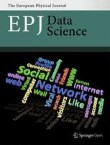Citation Impact 2023
Journal Impact Factor: 3.0
5-year Journal Impact Factor: 3.4
Source Normalized Impact per Paper (SNIP): 1.355
SCImago Journal Rank (SJR): 0.829
Speed 2023
Submission to first editorial decision (median days): 27
Submission to acceptance (median days): 234
Usage 2023
Downloads: 578,929
Altmetric mentions: 824



